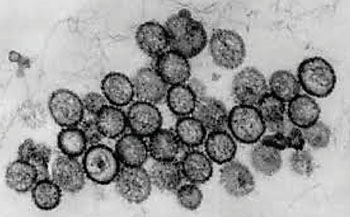Severe Hantavirus Disease Associated with Low Serum TGF-β Levels
By LabMedica International staff writers
Posted on 28 Apr 2015
Hantaviruses are emerging zoonotic pathogens which cause hemorrhagic fever with renal syndrome, an immune-mediated pathogenesis, and the role of transforming growth factor-β (TGF-β) expression in acute Hantavirus infection has been investigated. Posted on 28 Apr 2015
TGF-β has a pivotal function in the immune system and controls the initiation and resolution of inflammatory responses through the regulation of chemotaxis, activation, and survival of lymphocytes, natural killer cells, dendritic cells, macrophages, mast cells, and granulocytes.

Image: Transmission electron micrograph of Puumala virus (Photo courtesy of Hans R. Gelderblom and Freya Kaulbars).
Scientists at the University of Heidelberg (Germany) and their colleagues retrospectively studied 77 patients hospitalized with acute Puumala virus infection during a Hantavirus epidemic in Germany in 2012. The mean age of patients was 40.8 years, 52 were male (68%), five (6%) were under the age of 18 years. Polymerase chain reaction (PCR) for the detection of Hantavirus ribonucleic acid (RNA) was performed on the L-segment.
Sera were tested for Hantavirus immunoglobulin G (IgG) and IgM antibodies using the recomLine Hantavirus assay (Mikrogen; Munich, Germany), coated with specific Hantavirus nucleocapsid antigens of Puumala virus, Dobrava-Belgrade virus, Hantaan virus, and Seoul virus. TGF-β1, β2 and β3 were measured with the Luminex TGF assay (R&D Systems, Wiesbaden, Germany). All cytokines, neopterin and C-reactive protein (CRP) were determined on admission of the patients to the hospital and one week after admission.
Puumala virus RNA was detectable in 4/77 cases. Patients with severe disease had a significant longer hospital stay than patients with mild disease (6.2 days versus 3.6 days). Thrombocyte count 186/nL versus 225/nL), serum TGF-β1 (74 ng/L versus 118 ng/L) and TGF-β2 (479 pg/L versus 586 pg/L) were significantly lower in severe compared to mild disease. However, CRP was significantly higher in patients with severe disease (62 mg/L versus 40 mg/L). TGF-β1/Cr ratio was the most sensitive and specific marker associated with renal dysfunction.
The authors concluded that measurement of TGF-βs and especially TGF-βs/Cr ratios in the early phase of Puumala Hantavirus infection are very sensitive markers of kidney damage and that high expression of TGF-β1 and TGF-β2 are associated with milder courses of Hantavirus infection. High CRP is a marker of disease severity in Hantavirus infection. The results support the hypothesis of an immune-mediated pathogenesis of Hantavirus infection. The study was published on April 14, 2015, in the journal BMC Immunology.
Related Links:
University of Heidelberg
Mikrogen
R&D Systems













